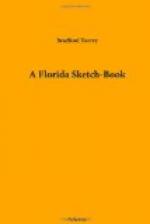Florida as I saw it (let the qualification be noted) is no more a land of flowers than New England. In some respects, indeed, it is less so. Flowering shrubs and climbers there are in abundance. I rode in the cars through miles on miles of flowering dogwood and pink azalea. Here, on this Tallahassee road, were miles of Cherokee roses, with plenty of the climbing scarlet honeysuckle (beloved of humming-birds, although I saw none here), and nearer the city, as already described, masses of lantana and white honeysuckle. In more than one place pink double roses (vagrants from cultivated grounds, no doubt) offered buds and blooms to all who would have them. The cross-vine (Bignonia), less freehanded, hung its showy bells out of reach in the treetops. Thorn-bushes of several kinds were in flower (a puzzling lot), and the treelike blueberry (Vaccinium arboreum), loaded with its large, flaring white corollas, was a real spectacle of beauty. Here, likewise, I found one tiny crab-apple shrub, with a few blossoms, exquisitely tinted with rose-color, and most exquisitely fragrant. But the New Englander, when he talks of wild flowers, has in his eye something different from these. He is not thinking of any bush, no matter how beautiful, but of trailing arbutus, hepaticas, bloodroot, anemones, saxifrage, violets, dogtooth violets, spring beauties, “cowslips,” buttercups, corydalis, columbine, Dutchman’s breeches, clintonia, five-finger, and all the rest of that bright and fragrant host which, ever since he can remember, he has seen covering his native hills and valleys with the return of May.
It is not meant, of course, that plants like these are wholly wanting in Florida. I remember an abundance of violets, blue and white, especially in the flat-woods, where also I often found pretty butterworts of two or three sorts. The smaller blue ones took very acceptably the place of hepaticas, and indeed I heard them called by that name. But, as compared with what one sees in New England, such “ground




